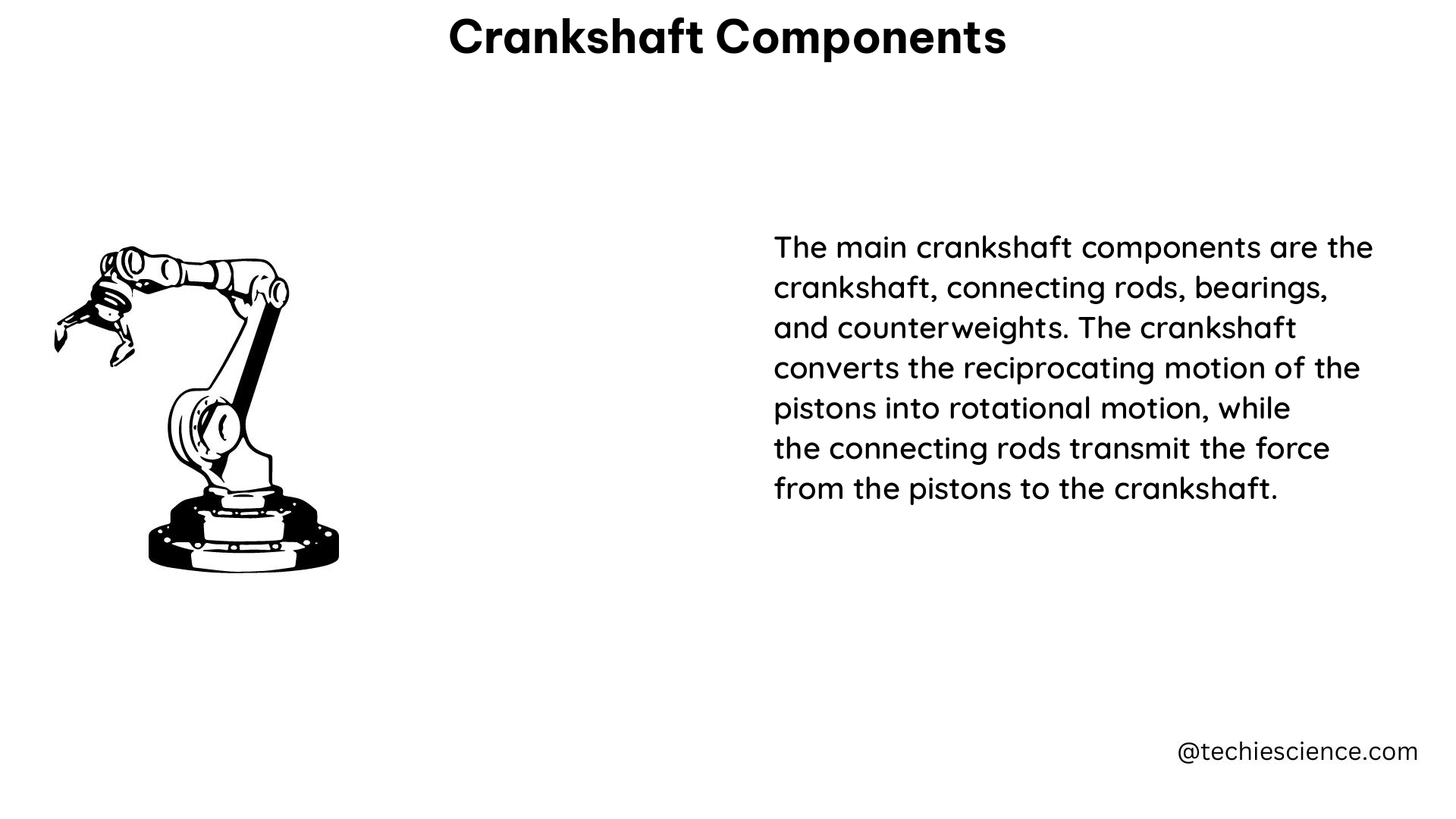The crankshaft is a critical component in an internal combustion engine, responsible for converting the linear motion of the pistons into the rotational motion that powers the vehicle. This comprehensive guide delves into the intricate details of crankshaft components, providing a valuable resource for mechanical engineering students and professionals alike.
Crankshaft Components: An Overview
The crankshaft is typically composed of several key components, each with its own specific technical specifications and requirements. These components include:
- Crankpin: The crankpin is the part of the crankshaft that connects to the connecting rod, allowing the linear motion of the piston to be converted into rotational motion.
- Main Journal: The main journal is the part of the crankshaft that rests in the engine’s main bearings, providing support and stability for the entire assembly.
- Counterweight: The counterweight is a heavy, offset component attached to the crankshaft that helps to balance the rotational forces and reduce vibrations.
- Thrust Surface: The thrust surface is the part of the crankshaft that interacts with the thrust bearing, which helps to maintain the proper axial position of the crankshaft within the engine.
Crankshaft Measurements: Ensuring Precision

Accurate measurement of the crankshaft is crucial to ensure proper fit and function within the engine. Here are some key considerations:
Measuring Crankshaft Journals
- Crankshaft journals can vary in size from place to place on the same journal, making precise measurement critical.
- Using a high-quality micrometer, measure the crankshaft at several points along each journal to ensure consistency.
- Recommended to have a competent machine shop measure the crankshaft or purchase from a trusted source, as grinding the crankshaft to an undersize can be necessary.
Crankshaft Geometry Measurement
- Crankshaft geometry measurement can be challenging due to the potential for elastic deformations, which can impact the accuracy of large crankshaft measurements.
- One method to increase the accuracy of these measurements is to use counterweights to minimize the elastic deformations, as discussed in the research paper “Method to Increase the Accuracy of Large Crankshaft Geometry Measurements Using Counterweights to Minimize Elastic Deformations.”
Crankshaft Stress Analysis: Ensuring Durability
Crankshaft stress analysis is critical to ensure the crankshaft can withstand the forces and loads it will experience during engine operation. This analysis typically includes:
- Experimental test data from engine and component testing
- Finite element modeling
- Multi-body simulation
- Stress recovery
- Fatigue analysis
- Fracture mechanics
These analyses are used to determine the service life of crankshafts, both with and without honeycomb features, based on factors such as threshold flaw size, service experience, and size distribution of actual flaws.
Crankshaft Geometrical Deviations: Ensuring Proper Fit
Determining the geometrical deviations of crankshafts is essential to ensure proper fit and function within the engine. A formula for supporting crankshaft measurements was proposed in the research paper “Determining geometrical deviations of crankshafts with limited detection possibilities due to support conditions,” which allowed for accurate assessment of these deviations.
Conclusion
The crankshaft is a complex and critical component in an internal combustion engine, and understanding its various components and their technical specifications is essential for mechanical engineering students and professionals. This comprehensive guide has provided a detailed overview of crankshaft components, measurement techniques, stress analysis, and geometrical deviations, equipping you with the knowledge to ensure the proper design, manufacture, and maintenance of this vital engine component.
References
- Help Understanding Crankshaft Measurements – https://forum.porsche356registry.org/viewtopic.php?t=25063
- Method to Increase the Accuracy of Large Crankshaft Geometry Measurements Using Counterweights to Minimize Elastic Deformations – https://www.researchgate.net/publication/342804152_Method_to_Increase_the_Accuracy_of_Large_Crankshaft_Geometry_Measurements_Using_Counterweights_to_Minimize_Elastic_Deformations
- Lycoming Crankshaft Special Certification Report (September 2004) – https://www.faa.gov/sites/faa.gov/files/2022-08/Lycoming_Crankshaft_Special_Certification_Report_Sep_04.pdf
- Determining geometrical deviations of crankshafts with limited detection possibilities due to support conditions – https://www.sciencedirect.com/science/article/pii/S026322412101318X

The lambdageeks.com Core SME Team is a group of experienced subject matter experts from diverse scientific and technical fields including Physics, Chemistry, Technology,Electronics & Electrical Engineering, Automotive, Mechanical Engineering. Our team collaborates to create high-quality, well-researched articles on a wide range of science and technology topics for the lambdageeks.com website.
All Our Senior SME are having more than 7 Years of experience in the respective fields . They are either Working Industry Professionals or assocaited With different Universities. Refer Our Authors Page to get to know About our Core SMEs.